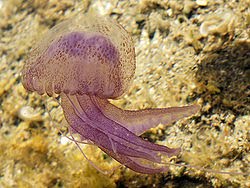At least I'm not a vegetarian. Are hooves and connective tissue really that much worse than muscle and skin? Before yesterday, I would have said absolutely, but now I have to reorganize my values. I thought Ashley was whacked yesterday making non-gelatin krispie treats. I also thought they were marshmellows, not mallows. But, it seems it was I who was whacked and woefully misinformed. My information is outdated by about 150 years. I shared my plight with a co-worker who plans to laugh at me for the next 3 weeks. He said, "What, you thought marshmallows came from the marshmallow plant, that grows on the bank of a marsh?"
Yes, that's exactly what I thought, dammit. I did some fancy internet research, and learned that I was right! Or, that I would have been right if it were just a century or so earlier.
From recipes.com
They are called "marshmallows" because part of the early recipe called for sap from the root of the marshmallow plant.
According to Merriam-Webster's Collegiate Dictionary, a marshmallow is:
1: a pink-flowered European perennial herb (Althaea officinalis) of the mallow family that is naturalized in the eastern U.S. and has a mucilaginous root sometimes used in confectionery and in medicine; 2: a confection made from the root of the marshmallow or from corn syrup, sugar, albumen, and gelatin beaten to a light spongy consistency
That word "mucilaginous" means "jelly-like." [My new favorite word.] Later, the root was replaced by gelatin, and that is how modern marshmallows are made.
From about.com
"Marshmallow candy dates back to ancient Egypt where it was a honey-based candy flavored and thickened with the sap of the root of the Marsh-Mallow plant (althea officinalis). Marsh-Mallow grows in salt marshes [HA!] and on banks near large bodies of water. [It must grow on the banks of the River Wahoo.] It is common in the eastern United States. Until the mid 1800's, marshmallow candy was made using the sap of the Marsh-Mallow plant. Gelatin replaces the sap in the modern recipes."
"Nineteenth century doctors extracted juice from the marsh mallow plant's roots and cooked it with egg whites and sugar, then whipped the mixture into a foamy meringue that later hardened, creating a medicinal candy used to soothe children's sore throats. Eventually, advanced manufacturing processes and improved texturing agents eliminated the need for the gooey root juice altogether. Unfortunately, that eliminated the confection's healing properties as a cough suppressant, immune system booster and wound healer."
So there is more than I ever wanted to know about marshMELLOWS. I want a marsh mallow plant and I want to try the real deal. Until then I must ponder the connective tissue assortment that I have ingested over the years.
rice krispie treats, smores, peeps, yes I like peeps, that weird chocolate orange mallow candy, mallomars, marshmallow fluff, mmm suck that right up, and just basic, pop em in your mouth, single mallowy marshmallows.
I don't think I want to stop, even though I'm flashing back to watching my dog slurp, shluurp, shhlluuurpp, his rawhide into soft, white, stringy, slimy, mucilaginous nastiness. The silver lining to all this, is that I might as well start eating jello again.
Thursday, May 1
Subscribe to:
Post Comments (Atom)
.jpg)
3 comments:
Oh dear I certainly did not mean to take over your day or anything, and I surely did not intend for you to be mocked by your co-worker. There are recipes out there for "real" marshmallows if you feel like concocting it. I wouldn't worry about it, you enjoy it so eat it. You want me to tell you what is in most cheese? mmmmm delicious rennet.
I don't know what rennet is, and I'm not going to look it up. My guess is that it's some sort of fermented colon scrapings. Whatever. From now on, if it's yummy, I'm eating it. If pig snot popsicles - or snotsicles were available, I'd at least sample one.
Mucilaginous... it's in my nose!
Post a Comment